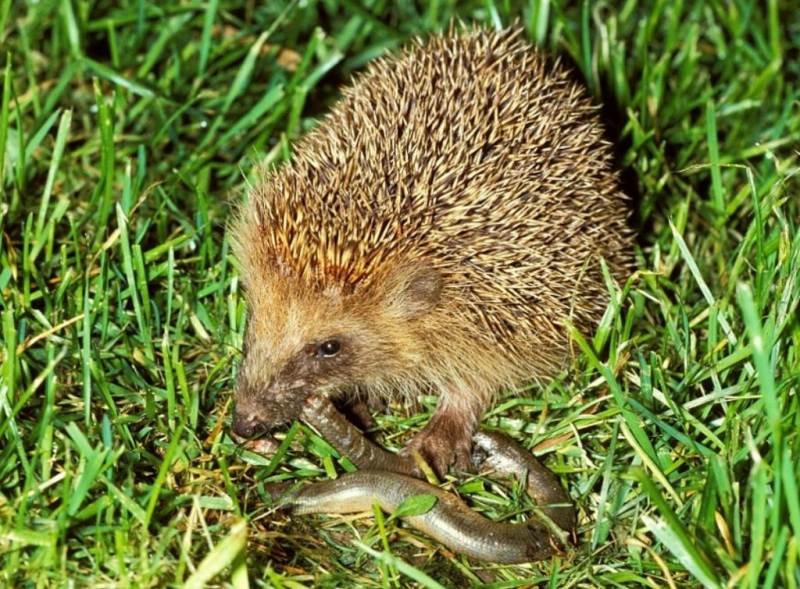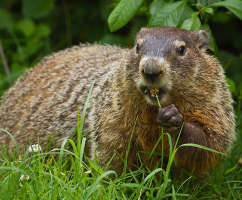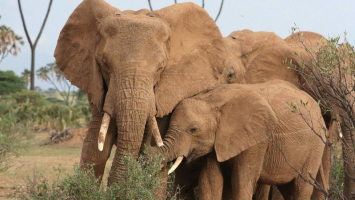Top 8 Snake Predators that Eat Snakes
Snakes are carnivorous reptiles that first appeared about 128 million years ago. Although snakes previously lived only in the southern regions with relatively ... read more...mild climates, they have successfully adapted to living in different parts of the world. It seems that this reptile scares everyone. But no, there are animals that consider snakes one of the best meals for dinner. Refer to the article below for more information on snake predators that eat snakes.
-
The snake predators that eat snakes that we would like to introduce to you first are the mongoose. Although the mongoose small animal but an excellent hunter, with a keen sense of smell, sight and hearing, and remarkable reflexes. They hunt insects and small animals such as mice, rats, rabbits, lizards, and snakes, including one of the most dangerous creatures on Earth - the king cobra.
The Mongoose is a frequent and active forager, eating a wide variety of small predators, and is particularly fond of snakes. All species of mongoose regularly eat snakes, but the slender mongoose and gray mongoose are the two most likely to confront and eat king cobras.
The mongoose is exceptionally agile and can dodge the attacks of the cobra very quickly. Most of them are immune to scorpion and snake venom. Still, mongooses also possess something called an acetylcholine receptor that makes them not completely immune, and repeated snake bites or attacks can cause them to get sick and even kill them. When the snake moves, the mongoose jumps up, baring its teeth, aiming directly at the snake's head. If the mongoose catches the snake correctly, it will kill it by biting right into its skull.

Photo: http://2.bp.blogspot.com/ 
Photo: https://i.pinimg.com/ -
Fearless animals like the honey badger will try to be the winner in any fight. Its diet is varied and one of the most dangerous snakes on the planet is part of its food. Honey badgers are excellent climbers and are not afraid of heights, which makes it easy to hunt for high-altitude prey, even snakes. In addition, their claws and teeth are very strong and made for fighting. They will not refuse to attack large predators to snatch their prey or cubs.
First of all, the honey badger's thick, loose skin with a thick, silky coat does a great job at preventing entry of the snake's fangs. The worst thing that can happen in the event of a snake bite is a coma for several hours. However, the animal will survive. In the body of the honey badger, it has specific proteins that work against the proteins in the snake venom, or there may be some other mechanism, such as an enzyme or other protein structure against which the venom has no effect.
Snakes are considered some of the honey badger's favorite foods. Even highly venomous snakes like black mambas and king cobras are on the menu. Despite the potential for a painful venomous snake bite, honey badgers are immune to the poison to a certain extent. One bite can kill other animals, but the bite means little to one of the honey badgers.

Photo: https://magazine.africageographic.com/ 
Photo: https://i.redd.it/ -
For many people, it is difficult to imagine a creature as small as a hedgehog hunting snakes. However, that is part of reality in nature. Hedgehogs are nocturnal animals, which means they do all their foraging at night. Almost all encounters between snakes and hedgehogs take place after nightfall.
The snake predators that eat snakes like porcupines are very clever at killing snakes, they begin their hunt by finding a snake and provoking it until the snake is angry enough to attack and defend itself. When allowed to attack, the hedgehog bit the snake from its neck a few times. The final blow hits the snake when its vertebrae are completely crushed. When fighting snakes, hedgehogs follow a special strategy called "bite and hide". Their efforts soon paid off. Whole meals can go on for several hours as their teeth get used to insects and smaller animals. A hedgehog will not consume the whole snake.
Although hedgehogs are immune to most snake poisons, they stand no chance of winning the war against king cobras. In addition, hedgehogs can easily attack small poisonous animals and kill them without being injured or affected by their poison. This unusual strength makes hedgehogs one of the more ruthless and specialized predators in the wild.

Photo: https://hedgehogregistry.org/ 
Photo: https://i.pinimg.com/ -
Owls are opportunists. Although all owls have their favorite prey, they will still hunt animals they don't like very much when food is limited. Some owls may seek out snakes because they like the smell of snakes. Snakes are a rich source of protein that some owls prefer over other food options.
Owls hunt by catching them and killing them quickly. This is true of almost all of their prey. They must kill the snake quickly to prevent it from fighting back, and they do this with the help of their strong beaks and razor-sharp talons. If they don't kill the snake quickly, it may squeeze or bite them. Instead, depending on its size, the snake may even try to eat them.
Great horned owls, striped owls, and Eastern and Western owls will often eat snakes. These owls are quite large, so doing so will be easier. In particular, large-horned owls can become obsessed with catching snakes, even too large snakes will not cause them to back down.
Although larger owls can kill snakes up to a staggering 7 feet in length, they generally prefer smaller snakes. Especially if the owl has a nest full of young owls, small snakes are perfect for feeding the baby owls. Baby snakes are soft, tasty, and nutritious, exactly what young owls need to grow and stay strong.

Photo: https://qph.fs.quoracdn.net/ 
Photo: https://i.ytimg.com/ -
The next snake predators that eat snakes that we want to introduce to you are the hawk. There are more than 200 species of hawks around the world, and there are an estimated 30 to 50 species of snake-eating hawks, and about 10 of them are exclusively snake-eaters. All known hawks are extremely sharp visionaries. They have five to six times better eyesight than humans, allowing them to see with the highest precision.
Their eyes are forward, which gives them excellent binocular vision. The hawk can accurately observe its prey from the smallest snakes from above while in flight. The reflexes of the hawks are very active and they attack very quickly and grab the snakes before it even realizes what has happened. They will only eat light snakes of medium to a small size that they can easily grab and fly.
Hawks have extremely sharp and muscular claws, and they are also commonly used to grip snakes. Small-sized snakes can be killed with a surprise attack using claws. The hawk's beak is very strong and has a hook. The beak is used by them to kill snakes by directly biting the snake's neck and using the beak to break the snake neck. Such attacks to break the neck are mostly seen if the snake is venomous. Others, snakes that don't die so easily, will soon suffocate when gripped by a hawk.

Photo: https://c1.staticflickr.com/ 
Photo: https://live.staticflickr.com/ -
The surprising snake predator that eats snakes here is cats, they are known for their excellent hunting skills. Cats not only hunt small animals for nutrition but also hunting is an important way for cats to entertain, exercise, and be mentally stimulated.
Cats can hunt and eat snakes. Sometimes, a snake will fight well and end up getting rid of a cat. However, cats are patient creatures that will sit around waiting for the perfect moment to pounce if they find a snake near them. Also, cats will only pounce on their prey if they are sure they can pass the prey without being too badly injured.
Cats can certainly kill any type of snake, they will almost certainly chase and kill snakes less than 6 feet long. The cats are agile, nimble, and intelligent, making them fierce opponents of snakes. This includes venomous snakes, as cats can quickly avoid a bite that immunizes the poison. When hunting, cats will often stalk and circle their prey. This prevents any snakes from escaping. The cat will usually play with the snake first and then jump back to avoid any attack from the snake. A cat scratch can kill a snake.

Photo: https://i.ytimg.com/ 
Photo: https://i.ytimg.com/ -
Snakes live by strict and sometimes cruel rules. Cannibalism is very common in their case. It's one of the ways that they reduce the number of specimens in their own population. Non-venomous snakes are notorious for killing their wild relatives. The king cobra is immune to the poisons of many other snakes in the world, which makes it an unbeatable predator of snakes.
It can stand up to look tall, so tall that it can look a person straight in the eye. Another feat it can do is it can propel itself forward. It can lift up to a third of its body and leap off the ground. King cobras are not usually aggressive towards humans. However, they will bite if cornered or during mating season. Their venom is so toxic that an elephant will die within hours of the king cobra delivering its venom.
The king cobra is probably the most intelligent snake in the world. They calculate and change their hunting strategies based on their specific prey and current circumstances. They are the longest venomous snakes with an average length of 11 to 13 feet.
The largest king cobra ever found was over 18 feet long. King cobras live in southern China, India, and Southeast Asia. They like streams, forests, bamboo bushes, and swamps. While these carnivorous hunters typically eat other snakes, birds, and lizards, they will also take advantage of other prey such as rodents when their food options are limited. According to snake preferences, the king cobra mainly eats Asian rat snakes, dhamans, and pythons. They will also like others such as Indian cobras, kraits, vipers, and wolf snakes.

Photo: https://www.aboutanimals.com/ 
Photo: http://2.bp.blogspot.com/ -
Like the king cobra, the kingsnake is on the list of snake predators that eat snakes. The "king" part of their name, like that of the king cobra, refers to their tendency to eat other snakes. These North American snakes are particularly fond of venomous species such as rattlesnakes, rattlesnakes, and field heads. The venom of these snakes does not affect them, so they are free to eat as much as they want.
Kingsnake can climb trees and swim. In addition to snakes, kingsnake also eats rodents, birds, bird eggs, lizards, and other snakes. These snakes are not venomous; instead, they kill their prey by squeezing it to death. The lifespan of these kingsnakes is 10 to 15 years.
Kingsnakes actively seek out other snakes as their prey. When hunting rattlesnakes or any other venomous snake, it uses a special technique that allows it to bite into the jaws of its prey to prevent it from fighting back. When the kingsnake finds another snake's head, it will crush it and start devouring it while it's still alive. In this case, suffocating the snake victim is the strategy. The victim snake will eventually die of suffocation if it cannot move because its head is stuck inside the kingsnake's throat.

Photo: https://images.fineartamerica.com/ 
Photo: http://justfunfacts.com/





























